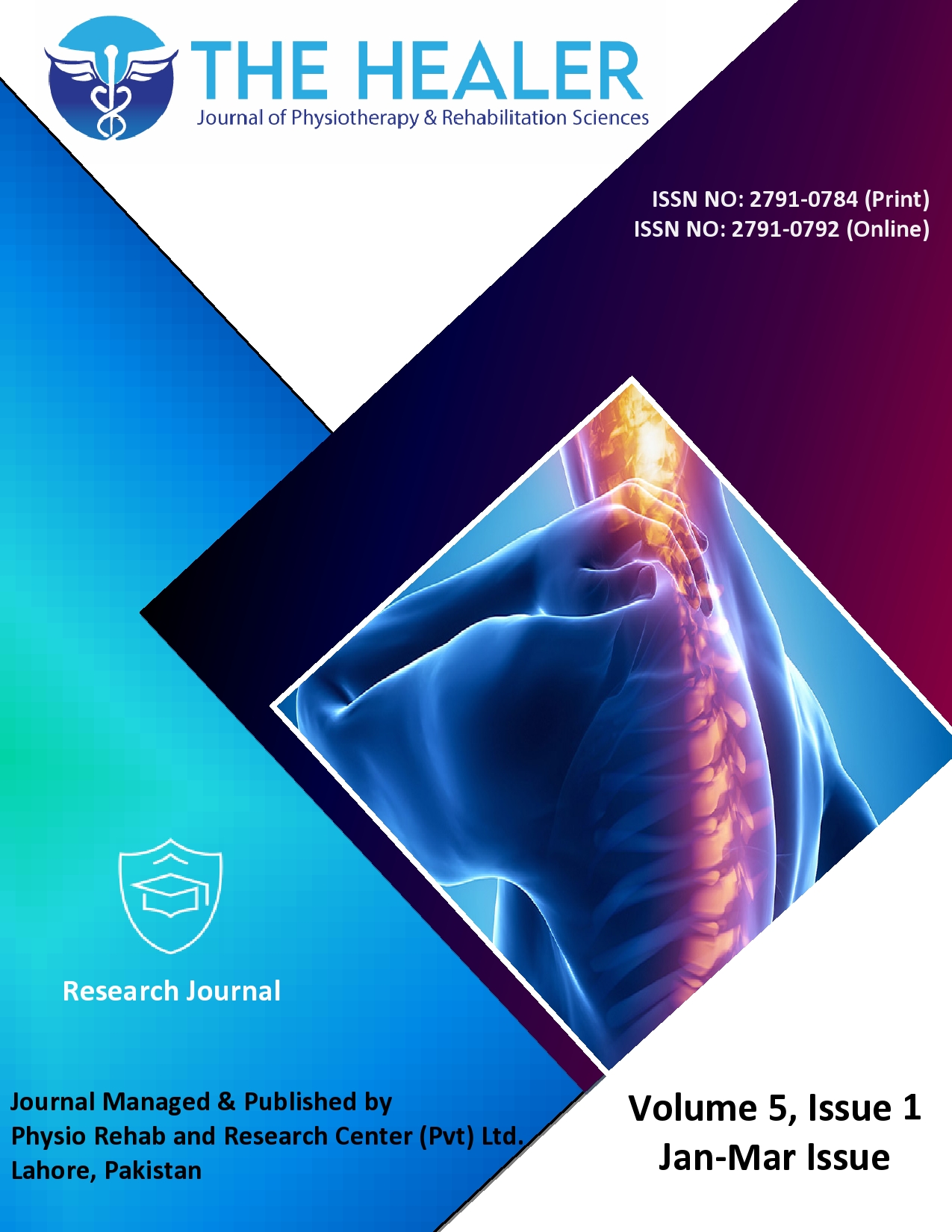Prevalence of Low Back Pain and Functional Disability in Post-Lumbar Laminectomy Patients: A Cross-sectional Study
DOI:
https://doi.org/10.55735/h062b308Keywords:
Degenerative disc, Low back pain, Lumbar laminectomy, Spinal decompression surgery, StenosisAbstract
Background: Understanding the impact of lumbar laminectomy on low back pain is essential for improving postoperative management and preventive strategies. Persistent low back pain after surgery can affect daily functioning and quality of life, highlighting the need for targeted interventions. Objective: To assess the prevalence, intensity, and functional disability associated with low back pain in post-lumbar laminectomy patients. Methodology: This cross-sectional study was conducted over six months in four major hospitals in Peshawar. The inclusion criteria consisted of 152 male and female post-lumbar laminectomy patients aged between 20 and 60 years who had undergone surgery at least three months before participation. Exclusion criteria included children, pregnant women, individuals with severe systemic diseases, or cognitive impairment. Before data collection, ethical approval was obtained from the Research Review Board of Iqra National University, Peshawar. Data were collected using the Oswestry Disability Index and the Numeric Pain Rating Scale. Descriptive statistics (mean, standard deviation, frequency, and percentage) were applied to summarize demographic and clinical data. The Chi-square test was used to determine associations between categorical variables such as age, gender, and disability levels, while the Linear-by-Linear Association test assessed trends between age and disability severity. Results: Participants ranged in age from 20 to 60 years, with a mean age of 40.66±10.02 years. About 92% of participants reported experiencing low back pain following lumbar laminectomy. No statistically significant association was found between gender and disability levels due to low back pain (p>0.05). A significant association was found between the variables age and disability level, with a p-value of 0.03. However, varying degrees of functional disability were reported, ranging from mild to complete. Conclusion: Gender was not significantly related to disability, but age was a significant factor, suggesting older patients face greater postoperative challenges. These findings emphasize the need for individualized rehabilitation strategies, regular follow-up, and targeted management to minimize functional disability and improve recovery outcomes.
Downloads
References
1. Clark S, Horton R. Low back pain: a major global challenge. The Lancet 2018; 391(10137): 2302.
https://doi.org/10.1016/S0140-6736(18)30725-6 DOI: https://doi.org/10.1016/S0140-6736(18)30725-6
2. Mattiuzzi C, Lippi G, Bovo C. Current epidemiology of low back pain. Journal of Hospital Management and Health Policy 2020; 4: 15
https://doi.org/10.21037/jhmhp-20-17 DOI: https://doi.org/10.21037/jhmhp-20-17
3. Urits I, Burshtein A, Sharma M, et al. Low back pain, a comprehensive review: pathophysiology, diagnosis, and treatment. Current Pain and Headache Reports 2019; 23(3): 23.
https://doi.org/10.1007/s11916-019-0757-1 DOI: https://doi.org/10.1007/s11916-019-0757-1
4. Khan HY, Khan SH, Gillani A, et al. Knowledge, attitudes and beliefs of clinical physiotherapists towards chronic back pain. National Journal of Life and Health Sciences 2024; 3(1): 20-4.
https://doi.org/10.62746/njlhs.v3n1.21 DOI: https://doi.org/10.62746/njlhs.v3n1.21
5. Shokri P, Zahmatyar M, Falah Tafti M, et al. Non‐spinal low back pain: Global epidemiology, trends, and risk factors. Health Science Reports 2023; 6(9): e1533.
https://doi.org/10.1002/hsr2.1533 DOI: https://doi.org/10.1002/hsr2.1533
6. Bonczar M, Koszewski J, Czarnota W, et al. The morphology of the lumbar vertebrae: a systematic review with meta-analysis of 1481 individuals with implications for spine surgery. Surgical and Radiologic Anatomy 2024; 47(1): 22.
https://doi.org/10.1007/s00276-024-03509-4 DOI: https://doi.org/10.1007/s00276-024-03509-4
7. Heuch I, Foss IS. Acute low back pain usually resolves quickly, but persistent low back pain often persists. Journal of Physiotherapy 2013; 59(2): 127.
https://doi.org/10.1016/S1836-9553(13)70166-8 DOI: https://doi.org/10.1016/S1836-9553(13)70166-8
8. Hartvigsen J, Hancock MJ, Kongsted A, et al. What low back pain is and why we need to pay attention. The Lancet 2018; 391(10137): 2356-67.
https://doi.org/10.1016/S0140-6736(18)30480-X DOI: https://doi.org/10.1016/S0140-6736(18)30480-X
9. Bogduk N. On the definitions and physiology of back pain, referred pain, and radicular pain. Pain 2009; 147(1-3): 17-9.
https://doi.org/10.1016/j.pain.2009.08.020 DOI: https://doi.org/10.1016/j.pain.2009.08.020
10. Bydon M, Macki M, Abt NB, et al. Clinical and surgical outcomes after lumbar laminectomy: an analysis of 500 patients. Surgical Neurology International 2015; 6(Suppl 4): S190-3.
https://doi.org/10.4103/2152-7806.156578 DOI: https://doi.org/10.4103/2152-7806.156578
11. Hatakka J, Pernaa K, Rantakokko J, Laaksonen I, Saltychev M. Effect of lumbar laminectomy on spinal sagittal alignment: a systematic review. European Spine Journal 2021; 30(9): 2413-26.
https://doi.org/10.1007/s00586-021-06827-y DOI: https://doi.org/10.1007/s00586-021-06827-y
12. Mehrpour S, Shafa S, Vatankhah M, et al. Pain management methods and techniques in lumbar disc surgery: a narrative review study. Iranian Journal of Neurosurgery 2024; 10: 4.
https://doi.org/10.32598/irjns.10.4 DOI: https://doi.org/10.32598/irjns.10.4
13. Yang X, Zhang S, Su J, et al. Comparison of clinical and radiographic outcomes between transforaminal endoscopic lumbar discectomy and microdiscectomy: a follow-up exceeding 5 years. Neurospine 2024; 21(1): 303-313.
https://doi.org/10.14245/ns.2347026.513 DOI: https://doi.org/10.14245/ns.2347026.513
14. Yeo J. Failed back surgery syndrome-terminology, etiology, prevention, evaluation, and management: A narrative review. Journal of Yeungnam Medical Science 2024; 41(3): 166-78.
https://doi.org/10.12701/jyms.2024.00339 DOI: https://doi.org/10.12701/jyms.2024.00339
15. Wang H, Wang T, Wang Q, Ding W. Incidence and risk factors of persistent low back pain following posterior decompression and instrumented fusion for lumbar disk herniation. Journal of Pain Research 2017; 10: 1019-25.
https://doi.org/10.2147/JPR.S132862 DOI: https://doi.org/10.2147/JPR.S132862
16. Alshammari HS, Alshammari AS, Alshammari SA, Ahamed SS, Alshammari H. Prevalence of chronic pain after spinal surgery: a systematic review and meta-analysis. Cureus 2023; 15(7): e41841.
https://doi.org/10.7759/cureus.41841 DOI: https://doi.org/10.7759/cureus.41841
17. Souza DBO, Barros MBA, Lima MG. Sex differences in the impact of musculoskeletal disorders on health-related quality of life: a population-based study, Campinas, SP-ISACamp 2014/15. Ciência & Saúde Coletiva 2024; 29(3): e18802022.
https://doi.org/10.1590/1413-81232024293.18802022 DOI: https://doi.org/10.1590/1413-81232024293.18802022
18. Wang Q-w, Man GC-w, Choi BC-y, et al. The predictors to self-reported and performance-based physical function in knee osteoarthritis patients: a cross-sectional study. Frontiers in Cell and Developmental Biology 2024; 12: 1406830.
https://doi.org/10.3389/fcell.2024.1406830 DOI: https://doi.org/10.3389/fcell.2024.1406830
19. Segal NA, Nilges JM, Oo WM. Sex differences in osteoarthritis prevalence, pain perception, physical function and therapeutics. Osteoarthritis and Cartilage 2024; 32(9): 1045-53.
https://doi.org/10.1016/j.joca.2024.04.002 DOI: https://doi.org/10.1016/j.joca.2024.04.002
20. Ruminski K. Understanding physical activity level among chronic pain patients: University of Georgia; 2024.
21. Hansen LA, Hartvigsen J, Jensen RK. Differences in demographics and clinical outcomes in older, middle-aged, and younger adults with low back pain receiving chiropractic care. Chiropractic & Manual Therapies 2025; 33(1): 31.
https://doi.org/10.1186/s12998-025-00589-w DOI: https://doi.org/10.1186/s12998-025-00589-w
22. Jiang Y, Yan X, Fu S, et al. A new surgery choice of bilateral laminoplasty for symptomatic three or more-level lumbar canal stenosis in patients over 60 years old: a two-year retrospective study. BMC Musculoskeletal Disorders 2025; 26(1): 680.
https://doi.org/10.1186/s12891-025-08940-1 DOI: https://doi.org/10.1186/s12891-025-08940-1
23. Azizi A, Siddiqui AM, Munshi N, Masroor MS, Salahuddin Z, Hassan M. Effect of intraoperative erector spinae block for faster recovery and reduced post-operative pain in patients undergoing discectomies & spinal decompression. Journal of Rawalpindi Medical College 2024; 28(3): 460-64.
https://doi.org/10.37939/jrmc.v28i3.2564 DOI: https://doi.org/10.37939/jrmc.v28i3.2564

Downloads
Published
License
Copyright (c) 2025 The Healer Journal of Physiotherapy and Rehabilitation Sciences

This work is licensed under a Creative Commons Attribution 4.0 International License.














